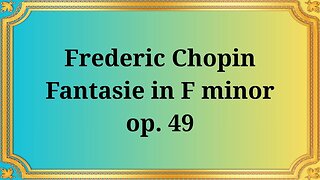Premium Only Content

Béla Bartók Music For String Instruments, Percussion, And Celesta
Publication date 1950
I. Andante tranquillo III. Adagio II. Allegro IV. Allegro molto
LOS ANGELES CHAMBER SYMPHONY conducted by HAROLD BYRNS
Béla Bartók's Music for String Instruments, Percussion, and Celesta is a groundbreaking piece of classical music that continues to captivate listeners to this day. Composed in 1936, the work is divided into four movements and was scored for two pianos, timpani, xylophone, celesta, and a string orchestra.
At the time of its composition, Bartók was at the height of his powers as a composer. He was known for his use of folk music and his exploration of new musical forms, and Music for String Instruments, Percussion, and Celesta showcases his innovative approach to composition.
The piece is characterized by its complex rhythms and harmonies. Bartók's use of asymmetrical rhythms and dissonant chords was groundbreaking at the time, and continues to inspire contemporary composers to this day. The use of percussion and celesta adds another layer of color and texture to the score, and stands out as particularly innovative for its time.
One of the defining qualities of Music for String Instruments, Percussion, and Celesta is its use of "night music." This term refers to the sections of the piece that are characterized by atmospheric, dreamlike textures and eerie melodies. These sections are intended to evoke a sense of mystery and otherworldliness, and serve as a key part of the emotional impact of the work.
Despite its initial reception as a challenging and unconventional work, Music for String Instruments, Percussion, and Celesta has become a beloved piece of the classical music canon. Its influence can be heard in the work of countless composers, and it continues to be performed and recorded by orchestras around the world.
In addition to its musical significance, Music for String Instruments, Percussion, and Celesta has been the subject of academic study and analysis. Its unconventional structure and use of folk music elements have made it a fascinating object of study for musicologists and theorists.
Ultimately, Music for String Instruments, Percussion, and Celesta stands as a testament to Bartók's unique artistic vision and his groundbreaking approach to composition. Its continued popularity and influence highlight the enduring power of innovative and boundary-pushing art.
You have the opportunity to support the channel https://destream.net/live/RadSiarAl/donate
-
 11:13
11:13
Classical music_Music Inspiration
1 month agoFrederic Chopin Fantasy in F minor, Op. 49
752 -
 20:36
20:36
It’s the Final Round
44 minutes agoNBA Best Bets & Player Props | Full Analysis & Predictions, FREE Today (Saturday 11/9) November 9th
1 -
 18:08
18:08
Professor Nez
2 hours ago⚠ Charlie Kirk WARNED America about Zohran Mamdani
2.65K28 -
 2:16:26
2:16:26
Megyn Kelly
22 hours agoBen Shapiro Responds to Tucker Carlson, Plus Sydney Sweeney and Newsom, with Knowles and Klavan
72.2K202 -
 2:10:39
2:10:39
LFA TV
23 hours agoRUMBLE RUNDOWN WEEK 5 with JEREMY HERRELL AND SHAWN FARASH 11.8.25 9AM
129K22 -
 56:11
56:11
X22 Report
4 hours agoMr & Mrs X - Women Are Fighting Back Against Men In Women's Spaces, It Has Begun - EP 15
49.8K22 -
 LIVE
LIVE
I_Came_With_Fire_Podcast
11 hours agoDark Hollywood, Ghosts on 'Cops', and Government Cover-Ups
183 watching -
 20:46
20:46
Jasmin Laine
1 day agoJoe Rogan Drops NUKE—Carney’s Secret Deal + 100,000 Kamloops Homes at Risk
22.5K37 -
 4:00
4:00
Mrgunsngear
1 day ago $21.36 earnedFirst They Came For Glock, Now They're Coming For The Ruger RXM
34.6K18 -
 1:42:46
1:42:46
Lara Logan
1 day agoINJECTING TRUTH INTO THE VACCINE DEBATE with Del Bigtree | Ep 43 | Going Rogue with Lara Logan
29.4K36